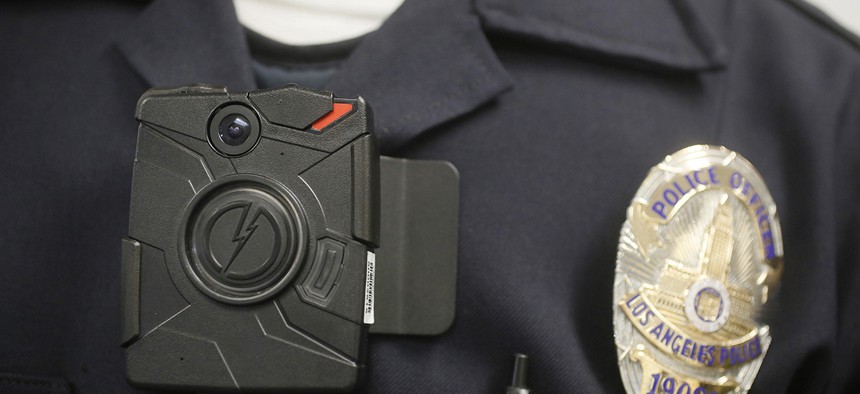Justice is Crafting a Body Camera Catalog for Local Police Forces

A Los Angeles Police officer wears an on-body camera during a demonstration. Damian Dovarganes/AP File Photo
Data protection and privacy controls are scattered throughout the seven-page list of characteristics that will be included in the guide.
This story has been updated to include comment from Justice Department spokeswoman Sheila Jerusalem.
The Justice Department plans to help police departments purchase wearable cameras by compiling a catalog of devices and has begun requesting product information from vendors.
Nationwide, there is a rush to shed more light onto the circumstances surrounding police shootings by equipping officers with body cameras. Concerns have been raised about certain manufacturers unfairly edging out competitors.
In preparation for the publication of a product comparison catalog, the National Institute of Justice has asked suppliers to suggest system features that should be described, as well as detail their current offerings. It plans to make the handbook available to law enforcement agencies by December 2016 at the latest, Sheila Jerusalem, a spokesperson for the National Institute of Justice, told Nextgov on Friday.
Data protection and privacy controls are scattered throughout the seven-page list of characteristics that will be included in the guide. As with other Web-enabled devices in the so-called Internet of Things, cop-cams can be hacked.
» Get the best federal technology news and ideas delivered right to your inbox. Sign up here.
"This market survey, which will identify commercially available body-worn camera systems, will be published by NIJ to assist purchasing agents or other representatives of law enforcement officials in their assessment of relevant information prior to making purchasing decisions," the April 28 information request states."Comments are invited with regard to the market survey, including which categories of information are appropriate for comparison, as well as promotional material (e.g., slick sheet) and print-quality photographs of the technology."
Of note, the department is not just in interested in devices worn on shoulders or chests, but also cameras with "mounting options." Think camera-studded utilitarian gear like goggles, military helmets and even sunglasses.
At this time, Justice expects that, at a minimum, the guidebook will cover five broad areas of information on each device: a) vendor, b) camera, c) video storage software, d) ease of use, and f) installation.
- Within those categories, there will be specs on optics, audio, data transmission and battery power, as well as numerous data validity elements, like GPS-recording options, facial recognition, and information storage security.
- The optics section asks about "means to authenticate and validate the integrity of the time/date stamp" to prevent evidence tampering.
- A safeguards section includes "privacy masking” -- a feature that blurs or completely blocks certain images to protect personal privacy and sensitive information. Justice also wants information on each camera systems' video redacting and editing capabilities.
- A part titled Export Capabilities asks whether there is "a traceability feature" that can identify who exported video or other data from the system.
- The department also wants to know about "weapons detection capabilities,” or the device’s ability to discern guns and knives from other objects.
- Under Video Security and Authentication, there is a space titled "encryption" features, for rendering data incomprehensible if intercepted by a hacker "while in transit and during storage."
- Other product functionalities that will be outlined: the availability and cost of software updates to patch security weaknesses discovered after purchase.
Nearly every week, reports surface about police-involved homicides in various locales, sometimes followed by news about the airing of footage of the situations.
On Wednesday, a body camera video of an incident in northern Colorado was released, in tandem with a Weld County district attorney's announcement that three officers were justified when they opened fire on Luke Nathan Miller, 37, on Feb. 25. The clip does not depict the actual shooting, but does show the suspect during and after the gunfire, according to Fox31 Denver.
As police forces get a move on outfitting all officers with wearable cameras, questions have arisen about the potential for one vendor in particular to corner the market.
Taser International, according to a report in The Wall Street Journal, has taught local officials how to avoid common contracting protocols, allowing it to clinch sales without facing competition. Taser officials say they are justified in inking "sole-source" deals for Tasers’ cameras because it is unlike any other service.
Baltimore police officers were to begin wearing Taser body cameras full-time starting May 1, under an $11.6 million deal, The Baltimore Sun reported in March. The announcement came a little less than a year after the death of Baltimore resident Freddie Gray from injuries sustained in a police van.






